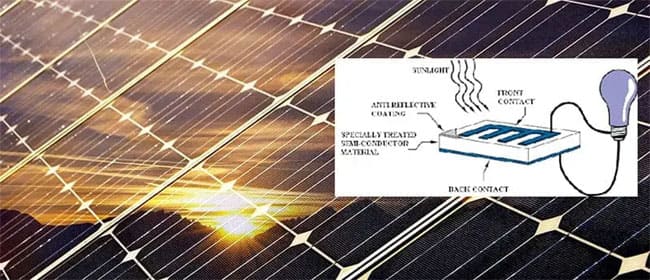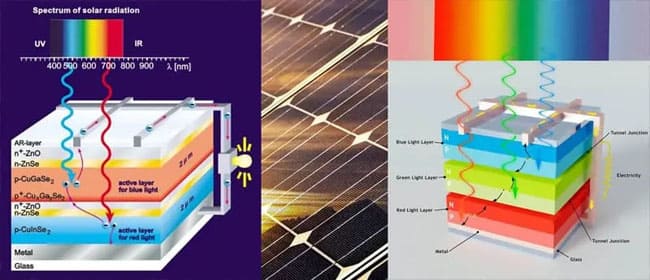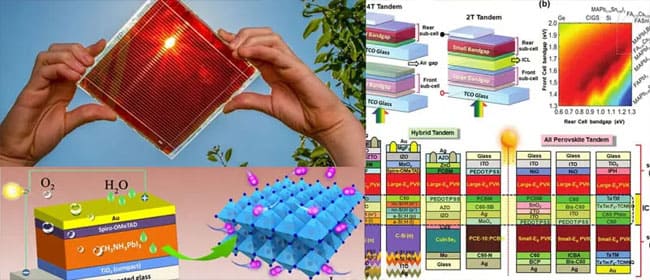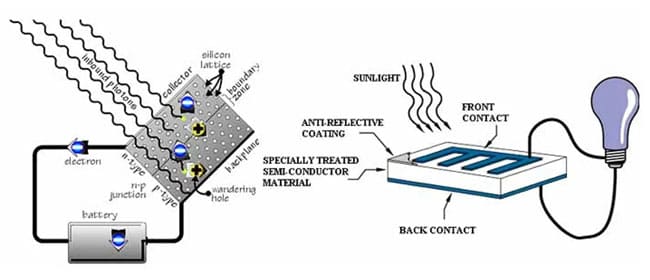Solar cells, also called photo-voltaic (PV) cells by scientists, convert sunlight directly into electricity. PV gets its name from the process of converting light (photons) to electricity (voltage), which is called the PV effect.
How do Photo-Voltaics Work?
Photo-Voltaics is the direct conversion of light into electricity at the atomic level. Some materials exhibit a property known as the photoelectric effect that causes them to absorb photons of light and release electrons. When these free electrons are captured, an electric current results that can be used as electricity.
The photoelectric effect was first noted by a French physicist, Edmund Bequerel, in 1839, who found that certain materials would produce small amounts of electric current when exposed to light. In 1905, Albert Einstein described the nature of light and the photoelectric effect on which photo-voltaic technology is based, for which he later won a Nobel prize in physics. The first photo-voltaic module was built by Bell Laboratories in 1954. It was billed as a solar battery and was mostly just a curiosity as it was too expensive to gain widespread use. In the 1960s, the space industry began to make the first serious use of technology to provide power aboard spacecraft. Through the space programs, the technology advanced, its reliability was established, and the cost began to decline. During the energy crisis in the 1970s, photo-voltaic technology gained recognition as a source of power for non-space applications.

The diagram above illustrates the operation of a basic photo-voltaic cell, also called a solar cell. Solar cells are made of the same kinds of semiconductor materials, such as silicon, used in the microelectronics industry. For solar cells, a thin semiconductor wafer is specially treated to form an electric field, positive on one side and negative on the other. When light energy strikes the solar cell, electrons are knocked loose from the atoms in the semiconductor material. If electrical conductors are attached to the positive and negative sides, forming an electrical circuit, the electrons can be captured in the form of an electric current -- that is, electricity. This electricity can then be used to power a load, such as a light or a tool.
A number of solar cells electrically connected to each other and mounted in a support structure or frame is called a photo-voltaic module. Modules are designed to supply electricity at a certain voltage, such as a common 12 volts system. The current produced is directly dependent on how much light strikes the module.
Multiple modules can be wired together to form an array. In general, the larger the area of a module or array, the more electricity that will be produced. Photo-voltaic modules and arrays produce direct-current (DC) electricity. They can be connected in both series and parallel electrical arrangements to produce any required voltage and current combination.

Today's most common PV devices use a single junction, or interface, to create an electric field within a semiconductor such as a PV cell. In a single-junction PV cell, only photons whose energy is equal to or greater than the band gap of the cell material can free an electron for an electric circuit. In other words, the photo-voltaic response of single-junction cells is limited to the portion of the sun's spectrum whose energy is above the band gap of the absorbing material, and lower-energy photons are not used.
One way to get around this limitation is to use two (or more) different cells, with more than one band gap and more than one junction, to generate a voltage. These are referred to as "multi-junction" cells (also called "cascade" or "tandem" cells). Multi-junction devices can achieve a higher total conversion efficiency because they can convert more of the energy spectrum of light to electricity.
As shown below, a multi-junction device is a stack of individual single-junction cells in descending order of band gap (Eg). The top cell captures the high-energy photons and passes the rest of the photons on to be absorbed by lower-band-gap cells.

Much of today's research in multi-junction cells focuses on gallium arsenide as one (or all) of the component cells. Such cells have reached efficiencies of around 35% under concentrated sunlight. Other materials studied for multi-junction devices have been amorphous silicon and copper indium diselenide.
As an example, the multi-junction device below uses a top cell of gallium indium phosphide, "a tunnel junction," to aid the flow of electrons between the cells, and a bottom cell of gallium arsenide.






